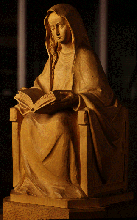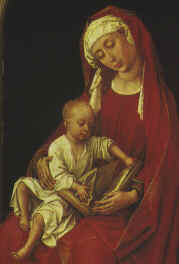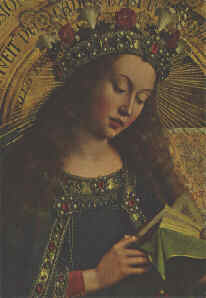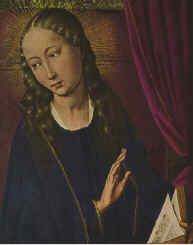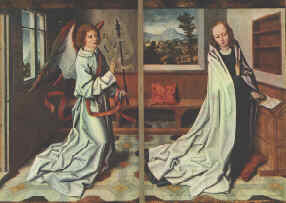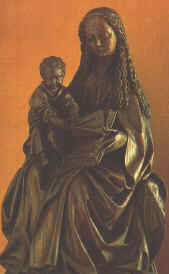Our Lady of the Book
Our Lady of the Book
– Reverend Eamon R. Carroll, O.Carm.
Christian artists have often depicted the Blessed Virgin as reading, especially at the Annunciation. She is shown seated with a book; Gabriel is coming on the scene to deliver the message from heaven for which God's written word has prepared Mary. "The angel of the Lord declared unto Mary," as the familiar Angelus begins, "and she conceived of the Holy Spirit." Sometimes God's angelic messenger holds a scroll with the legend, "Hail, full of grace, the Lord is with you." In medieval art the Blessed Virgin is often shown kneeling at a priedieu, totally taken up in reading and prayer.
Renaissance art sometimes shows the child Mary reading a book, with her parents Joachim and Anne. Murillo painted St. Anne and the child Mary reading. Rubens has Anne teaching Mary out of a book.
A striking modern example is John Angel's sculpture over the main entrance of the National Shrine of the Immaculate Conception, Washington, D.C. Mary is kneeling at her priedieu, a book before her, as Gabriel approaches from behind her, surprising her in prayer. The scene is vibrant with energy: Gabriel's wings are still extended, and the pious maiden looks back over her shoulder to God's envoy. There is a photo of this sculpture on the cover of the United States Bishops' pastoral of November 21, 1973, Behold Your Mother, Woman of Faith (U.S.C.C., Washington, D.C., still in print, in English and Spanish). Other artistic representations continue the theme into our own day. Sometimes it is Our Lady teaching the Christ-child to read, even the boy Jesus explaining the holy book to his mother. After Pentecost Our Lady is still shown with an unrolled scroll, one of the apostles close by to learn from her.
Symbolism of the Images
What is behind the representation of Our Lady of the Book? We find three lessons in the scene:
- Mary herself reads;
- the perfect correspondence between what was foretold in the Bible and its fulfilment in the birth and life of Jesus;
- Mary is herself the 'book' in which the Church reads the ways of God.
The first meaning is Mary as reader; she reads in the fullest sense, that is, she searches, she understands, she prays, she opens her mind and heart to whatever message God will send her through his sacred word. A second sense of Our Lady and the book is the correspondence in her life between God's promises and their fulfilment in Jesus her Son. Gabriel is quoting the same prophecies Mary is reading, and as she consents to become Mother of the Savior, the forecasts become reality.
She has said, "Behold the handmaid of the Lord, be it done unto me according to your word," and as the Angelus continues, "and the Word was made flesh and dwelt among us." The pattern of the Annunciation - Our Lady's total surrender to God's saving plan - characterizes her entire life. Of this "daughter of Abraham," more than of any of his children, will the followers of Jesus say, "You have great faith!" (Mt 16, 28) The holy Virgin is a true child of Abraham, who produces appropriate fruit. (Lk 3, 8) Elizabeth's words, "Blest is she who trusted that the Lord's words to her would be fulfilled," are repeated in her Son's praise, "Still more blessed are those who hear the word of God and keep it." (Lk 11, 28) The book is a symbol of Jesus himself; Mary is the reader. First she reads the messianic prophecies of the Hebrew Bible, then their achievement in her divine Son.
A third element in the tradition of Mary and the book is that the Blessed Virgin is herself a book in which the Church reads, a reading that began with the apostles. Early authors call Mary "the sacred book of the divine precepts, in which what pleases God is made known to us, as Jeremias saw long ago...." (St. Theodore of Studion, D. 826) One compiler tracked down ninety titles in which Mary is described as a book.
Books enshrine the past, both words and deeds. St. Luke twice assures us that the Mother of Jesus kept in her heart and memory everything that pertained to her Son. Pope John Paul II has described biblical ways Mary searched out God's ways: at the Annunciation - "deeply troubled ... she wondered," she asked, "How can this be?" in her reactions to the words of the shepherds and her twelve-year-old at Jerusalem in the temple.
At the visit of the shepherds St. Luke tells us, "Mary treasured all these things and reflected on them in her heart." At the finding of the boy Jesus in the temple, the gospel says Mary and Joseph did not grasp what he said about being in his Father's house. All the same, concluded St. Luke, "His mother kept all these things in memory," while her Son returned with them to Nazareth, to obey them and to "progress steadily in wisdom and age and grace before God and men." Some bible translations have: "Mary kept all these words, pondering them in her heart."
St. Luke would have us understand far more than mere memory on Mary's part. She remembered and compared, turning over and over in her heart what she had heard and seen and experienced, seeking ever more profound appreciation and acceptance of God's mysterious and merciful ways. In the litany we call Mary seat or throne of wisdom, meaning that divine Wisdom, the Word of God, the Second Person of the Blessed Trinity, made his dwelling place in her pure body. She is also the virgin most wise, as the newly-approved translation of her litany has for the older virgin most prudent.
A conciliar document on Revelation (Nov. 18, 1965) in explaining tradition, presented Our Lady as the model of how the Church, guided by the Holy Spirit, "grows in the understanding of the realities and words which are being passed on. This happens through the contemplation and study made by believers, who treasure these things in their hearts (cf. Luke 2, 19 and 51), through the intimate understanding of spiritual things they experience, and through the preaching of those who have received through episcopal succession the sure gift of truth." (n. 8)
Our Lady of the book can teach us still how to pray better; we never grow too old to learn from the Mother of Jesus, the gospel woman of faith so well versed in God's holy word. A confrere of mine, Father Joachim Smet, wrote the poem "Our Lady of the Book," here presented with his permission, and for its arrangement the permission of America magazine where it first appeared November 27, 1943:
Our Lady wears no dearer look
Than when she's reading in a book.
For then the virgin named most Wise
Reveals her schoolgirl's earnest eyes.
A furrow grace where eyebrows meet
I trace in her called Wisdom's Seat
The hands that steady Jesus' pace
Now cautiously each letter trace.
And Anna's lessons learned so slow
Seem long ago, seem long ago.
Our Lady wears no dearer look
Than when she's reading in a book.
For then the virgin named most Wise
Reveals her schoolgirl's earnest eyes.
A furrow grace where eyebrows meet
I trace in her called Wisdom's Seat
The hands that steady Jesus' pace
Now cautiously each letter trace.
And Anna's lessons learned so slow
Seem long ago, seem long ago.
The above meditation is an excerpt from an article written by a professor of the International Marian Research Institute, Eamon R. Carroll, O.Carm. Fr. Carroll is also Professor of Theology at Loyola University of Chicago. The author acknowledges his indebtedness to Jean Leclerq, O.S.B., "Mary's Reading of Christ," in Monastic Studies (Montreal) 15 (1984) 106-117. The America article: Reprinted with permission of America Press, Inc., 106 West 56th St., New York, NY 10019.
All About Mary includes a variety of content, much of which reflects the expertise, interpretations and opinions of the individual authors and not necessarily of the Marian Library or the University of Dayton. Please share feedback or suggestions with marianlibrary@udayton.edu.

